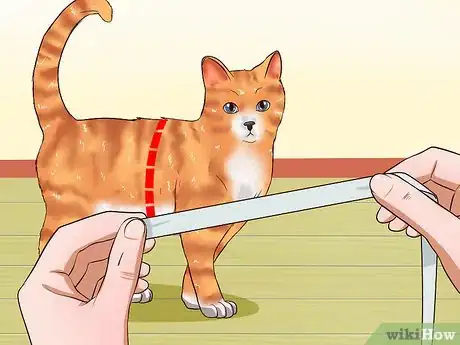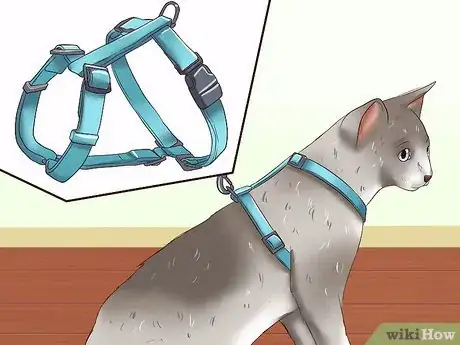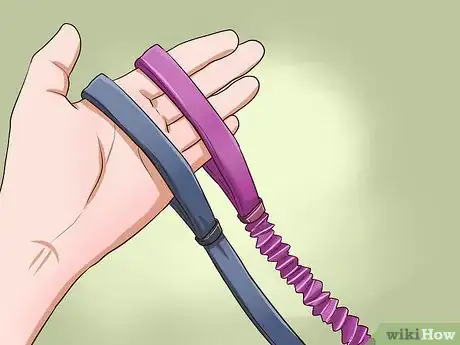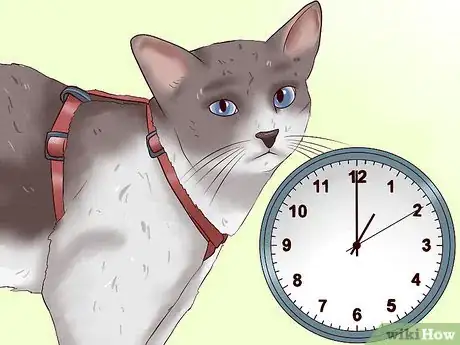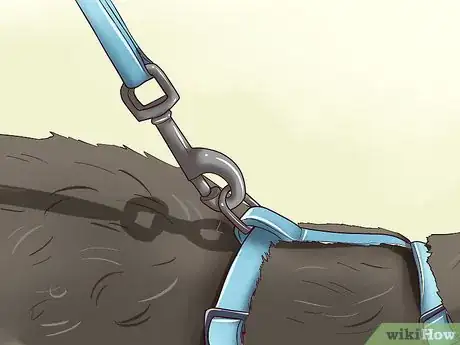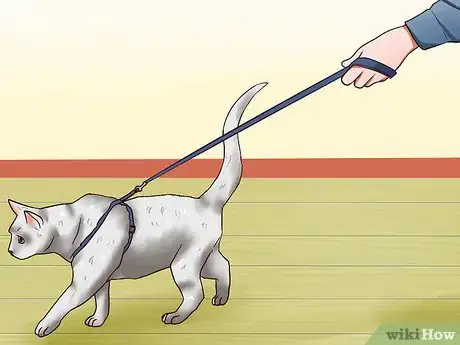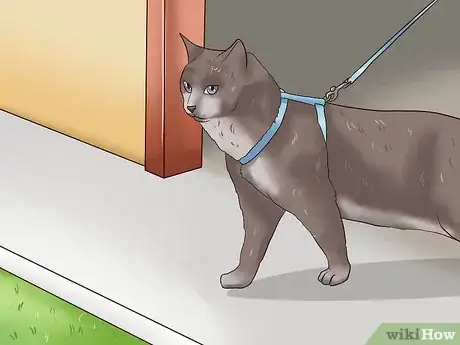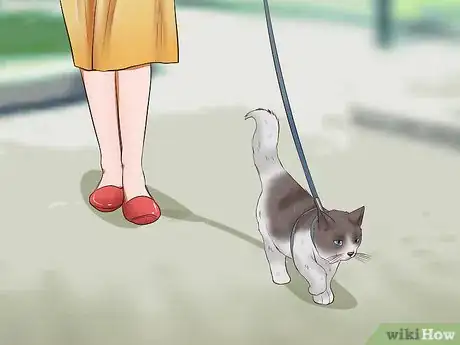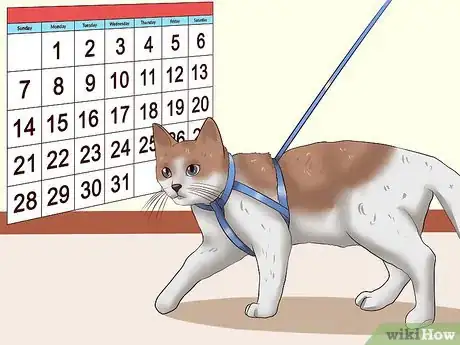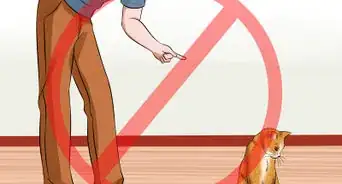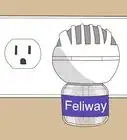This article was co-authored by Molly DeVoss. Molly DeVoss is a Certified Feline Training and Behavior Specialist (CFTBS), a Certified Cat Behavior Consultant (CCBC), a Fear Free Certified Trainer (FFCT), and the Founder of Cat Behavior Solutions. Molly specializes in using positive reinforcement to modify and prevent unwanted behaviors in cats and reduce cat shelter surrender. Molly has sat on the Dallas Animal Advisory committee since 2013 and was voted one of the Top 12 Extraordinary Cat Behaviorists of 2020 by Catpetclub.com. She is certified by both the Animal Behavior Institute and the International Association of Animal Behavior Consultants. She is also the host of the weekly podcast Cat Talk Radio.
wikiHow marks an article as reader-approved once it receives enough positive feedback. This article received 12 testimonials and 85% of readers who voted found it helpful, earning it our reader-approved status.
This article has been viewed 696,503 times.
Teaching a cat to walk on a leash allows an indoor cat safe access to the great outdoors. Leash training can also be a good stepping stone if you eventually want to help your cat go outside unattended. When teaching your cat to go outside with a leash, it’s important for you to remember that the outdoors can initially seem overwhelming to a cat used to the indoors.[1] Be sympathetic and patient if your cat at first seems alarmed or panicked. It will take time for your cat to feel comfortable with wearing a harness and going outside, so take things slowly and reward your cat with ample praise and lots of treats. Read on to learn how to get your cat safely out and exploring.
Steps
Choosing a Harness
-
1Take your cat’s measurements. In order to go walking outdoors with you, your cat will need a well-fitted harness--never use a leash and collar.[2] [3] If you’re walking your cat with a collar and the cat bolts--which cats are very likely to do--the collar can damage the cat’s windpipe, voice box, and ability to swallow. A harness will distribute the force of restraint between the cat’s shoulders, chest, and belly, making it less likely your cat will get injured.
- To get your cat’s harness measurements, measure around the girth around your cat’s chest, just behind the front legs and note it down. Bring the measurement with you when you go to buy the harness.
-
2Choose a harness. Most cat harnesses are made with adjustable straps designed to fit either kittens or adult cats and are made of either nylon or neoprene. Some harnesses may come in sub-sizes based on your cat’s specific measurements.
- The harness should be fitted to your cat’s body and should neither squeeze or cut into your cat or hang loosely off its body. If it’s fitted properly, you should just be able to fit two fingers under the harness when you put it on your cat.
- Never use a harness as a restraint for car rides--cat harnesses aren’t designed to protect cats in the event of a car accident.
Advertisement -
3Choose a leash. Cats have different leash needs than dogs, so choose an appropriate leash carefully.
- Some manufacturers make lighter-weight leashes designed specifically for cats, as cats are generally lighter and less forceful than dogs.
- Bungee leashes are ideal for cats because they provide enough stretch to let your cat safely wander a bit.
- Avoid using retractable leashes (commonly sold for dogs) with a cat, as the leash is ill-suited to and can injure a cat.
- Opt for a short leash instead of a long one. A short leash will keep your cat from darting out into traffic or getting tangled up.[4]
Allowing Your Cat to Adjust to the Harness
-
1Put your cat in its harness for short periods of time. Before you’ll be able to take your cat outside, you’ll first need to get it accustomed to wearing its harness.
- Start by putting your cat in its harness for short periods of time every day for several days. Initially, put the harness on for just a few minutes, then increase the length of time each day for several days.[5]
- Give your cat treats and lots of praise while putting on the harness and while your cat walks around wearing the harness.[6]
- You want your cat to eventually feel comfortable moving around the house in its harness, ideally to the point that it doesn’t pay any mind to the harness.[7]
-
2Attach the leash. Once your cat has become comfortable with its harness, begin attaching the leash to the harness.
- At first, allow the leash to trail behind your cat. Encourage the cat to walk around with the leash attached by offering treats and lots of praise.
-
3Practice walking with the harness and leash. Once your cat has become comfortable having the leash trail behind it, pick up the leash and again encourage your cat to walk around--this time with you holding the leash.
- Offer your cat its favorite treats and lots of praise as it begins to walk around. Try not to yank or drag the cat along as you go--let the cat move about of its own volition.
Helping Your Cat Go Outdoors
-
1Start slowly. Don’t force your cat to go outdoors. The prospect of going outside can be quite intimidating to some cats, so if your cat is reluctant to follow you out, don’t insist.[8]
- If your cat is unsure about going out, just leave the door open so it can get its bearings and take its time. If your cat doesn’t want to venture out, try again another day and be patient--it may take time.
- Pay close attention to your cat's body language. If they feel uncomfortable, end the walk.[9]
-
2Help your cat venture outdoors. Once your cat is ready to make its way outside, follow behind and offer encouragement with treats and praise.[10]
- Keep the trip short--about five minutes. Any longer and your cat may become overwhelmed and be less willing to go outside again in the future.[11]
- Wait for a dry day to go outside. If it’s raining or has recently rained, many of the normal scents your cat would use to navigate will have been washed away and your cat may have difficulty getting its bearings.
-
3Take your cat out regularly. Gradually increase the length of time you allow your cat to stay outside and make outside trips part of your cat’s regular routine.
- As your cat becomes more comfortable outside, allow it to wander farther from you if it chooses. Follow at the distance that the leash allows.
Expert Q&A
-
QuestionIs it easy to leash train a cat?
 Molly DeVossMolly DeVoss is a Certified Feline Training and Behavior Specialist (CFTBS), a Certified Cat Behavior Consultant (CCBC), a Fear Free Certified Trainer (FFCT), and the Founder of Cat Behavior Solutions. Molly specializes in using positive reinforcement to modify and prevent unwanted behaviors in cats and reduce cat shelter surrender. Molly has sat on the Dallas Animal Advisory committee since 2013 and was voted one of the Top 12 Extraordinary Cat Behaviorists of 2020 by Catpetclub.com. She is certified by both the Animal Behavior Institute and the International Association of Animal Behavior Consultants. She is also the host of the weekly podcast Cat Talk Radio.
Molly DeVossMolly DeVoss is a Certified Feline Training and Behavior Specialist (CFTBS), a Certified Cat Behavior Consultant (CCBC), a Fear Free Certified Trainer (FFCT), and the Founder of Cat Behavior Solutions. Molly specializes in using positive reinforcement to modify and prevent unwanted behaviors in cats and reduce cat shelter surrender. Molly has sat on the Dallas Animal Advisory committee since 2013 and was voted one of the Top 12 Extraordinary Cat Behaviorists of 2020 by Catpetclub.com. She is certified by both the Animal Behavior Institute and the International Association of Animal Behavior Consultants. She is also the host of the weekly podcast Cat Talk Radio.
Certified Feline Training and Behavior Specialist & Certified Cat Behavior Consultant Certified Feline Training and Behavior Specialist & Certified Cat Behavior ConsultantExpert AnswerNot necessarily—cats are highly territorial, so when you take a cat out of its home, they might feel threatened. Pay really close attention while you're out and about with your cat, and bring them back inside if they seem uncomfortable. You don't want your cat associating walks with nervous, anxious feelings!
Certified Feline Training and Behavior Specialist & Certified Cat Behavior ConsultantExpert AnswerNot necessarily—cats are highly territorial, so when you take a cat out of its home, they might feel threatened. Pay really close attention while you're out and about with your cat, and bring them back inside if they seem uncomfortable. You don't want your cat associating walks with nervous, anxious feelings! -
QuestionWhat kind of leash is best for cats?
 Molly DeVossMolly DeVoss is a Certified Feline Training and Behavior Specialist (CFTBS), a Certified Cat Behavior Consultant (CCBC), a Fear Free Certified Trainer (FFCT), and the Founder of Cat Behavior Solutions. Molly specializes in using positive reinforcement to modify and prevent unwanted behaviors in cats and reduce cat shelter surrender. Molly has sat on the Dallas Animal Advisory committee since 2013 and was voted one of the Top 12 Extraordinary Cat Behaviorists of 2020 by Catpetclub.com. She is certified by both the Animal Behavior Institute and the International Association of Animal Behavior Consultants. She is also the host of the weekly podcast Cat Talk Radio.
Molly DeVossMolly DeVoss is a Certified Feline Training and Behavior Specialist (CFTBS), a Certified Cat Behavior Consultant (CCBC), a Fear Free Certified Trainer (FFCT), and the Founder of Cat Behavior Solutions. Molly specializes in using positive reinforcement to modify and prevent unwanted behaviors in cats and reduce cat shelter surrender. Molly has sat on the Dallas Animal Advisory committee since 2013 and was voted one of the Top 12 Extraordinary Cat Behaviorists of 2020 by Catpetclub.com. She is certified by both the Animal Behavior Institute and the International Association of Animal Behavior Consultants. She is also the host of the weekly podcast Cat Talk Radio.
Certified Feline Training and Behavior Specialist & Certified Cat Behavior Consultant Certified Feline Training and Behavior Specialist & Certified Cat Behavior ConsultantExpert AnswerAlways pick out a short leash for your cat. This will stop your kitty from running out into the street or getting tangled up in something.
Certified Feline Training and Behavior Specialist & Certified Cat Behavior ConsultantExpert AnswerAlways pick out a short leash for your cat. This will stop your kitty from running out into the street or getting tangled up in something. -
QuestionDo cats like walking on a leash?
 Molly DeVossMolly DeVoss is a Certified Feline Training and Behavior Specialist (CFTBS), a Certified Cat Behavior Consultant (CCBC), a Fear Free Certified Trainer (FFCT), and the Founder of Cat Behavior Solutions. Molly specializes in using positive reinforcement to modify and prevent unwanted behaviors in cats and reduce cat shelter surrender. Molly has sat on the Dallas Animal Advisory committee since 2013 and was voted one of the Top 12 Extraordinary Cat Behaviorists of 2020 by Catpetclub.com. She is certified by both the Animal Behavior Institute and the International Association of Animal Behavior Consultants. She is also the host of the weekly podcast Cat Talk Radio.
Molly DeVossMolly DeVoss is a Certified Feline Training and Behavior Specialist (CFTBS), a Certified Cat Behavior Consultant (CCBC), a Fear Free Certified Trainer (FFCT), and the Founder of Cat Behavior Solutions. Molly specializes in using positive reinforcement to modify and prevent unwanted behaviors in cats and reduce cat shelter surrender. Molly has sat on the Dallas Animal Advisory committee since 2013 and was voted one of the Top 12 Extraordinary Cat Behaviorists of 2020 by Catpetclub.com. She is certified by both the Animal Behavior Institute and the International Association of Animal Behavior Consultants. She is also the host of the weekly podcast Cat Talk Radio.
Certified Feline Training and Behavior Specialist & Certified Cat Behavior Consultant Certified Feline Training and Behavior Specialist & Certified Cat Behavior ConsultantExpert AnswerNot really. Your cat definitely won't want to walk fast or jog with you like a dog might.
Certified Feline Training and Behavior Specialist & Certified Cat Behavior ConsultantExpert AnswerNot really. Your cat definitely won't want to walk fast or jog with you like a dog might.
Warnings
- Remember that a cat will behave differently than a dog. Don’t expect your cat to happily trot along beside you on a walk because it very probably won’t. Leash training a cat is primarily to allow a cat to go outdoors in a safe and controlled way, not about training your cat to be a substitute dog.⧼thumbs_response⧽
- Cats are naturally cautious animals and are likely to bolt if faced with unfamiliar stimuli. When you take your cat outside, be prepared for it to try to run and hide. Keep a firm hold on the leash and stay close, offering treats and lots of praise as encouragement.⧼thumbs_response⧽
- Vaccination is mandatory when taking your cat outside (and is highly advisable even if your cat always stays indoors). Diseases such as cat distemper are spread by viruses that can lie dormant in the environment for weeks, so a cat doesn’t need to have direct contact with an infected cat to pick up infection or illness. Talk to your veterinarian about which vaccines are recommended in your area.[12]⧼thumbs_response⧽
References
- ↑ Molly DeVoss. Certified Feline Training and Behavior Specialist & Certified Cat Behavior Consultant. Expert Interview. 15 July 2021.
- ↑ http://www.drsfostersmith.com/pic/article.cfm?aid=2508
- ↑ Molly DeVoss. Certified Feline Training and Behavior Specialist & Certified Cat Behavior Consultant. Expert Interview. 15 July 2021.
- ↑ Molly DeVoss. Certified Feline Training and Behavior Specialist & Certified Cat Behavior Consultant. Expert Interview. 15 July 2021.
- ↑ Cat Training Secrets. Patricia Mayo. Publisher: Talent Writers
- ↑ Cat Training Secrets. Patricia Mayo. Publisher: Talent Writers
- ↑ Cat Training Secrets. Patricia Mayo. Publisher: Talent Writers
- ↑ Cat Training Secrets. Patricia Mayo. Publisher: Talent Writers
- ↑ Molly DeVoss. Certified Feline Training and Behavior Specialist & Certified Cat Behavior Consultant. Expert Interview. 15 July 2021.
About This Article
To leash train your cat, start by putting it in its harness for just a few minutes at a time, and gradually increase the length of time in harness over several days so your cat can get used to it. When your cat seems comfortable in its harness, attach the leash and let your cat trail it around behind them. You can then start picking up the leash and walking around with your cat. Practice inside before you venture outside for your first short trips. Finally, be sure to encourage your cat at every stage of training by offering treats and lots of praise. For information from our Veterinary reviewer on getting the right harness and leash to train your cat, read on!

